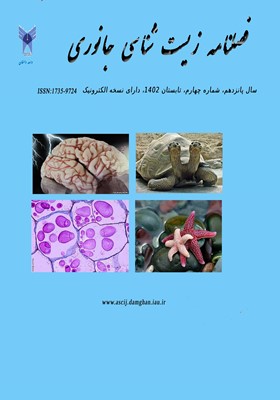بررسی پتانسیل داربست چاپ سهبعدی پلی کاپرولاکتون پوشش داده شده با بیوسرامیکها در تکثیر و تمایز استخوانی سلولهای بنیادی مزانشیمی بافت چربی انسانی
محورهای موضوعی : فصلنامه زیست شناسی جانوری
نسرین ّفاضلی
1
,
احسان عارفیان
2
,
شیوا ایرانی
3
![]() ,
عبدالرضا اردشیری لاجیمی
4
,
عبدالرضا اردشیری لاجیمی
4
![]() ,
احسان سیدجعفری
5
,
احسان سیدجعفری
5
1 - گروه زیستشناسی، دانشکده فناوری های همگرا، واحد علوم و تحقیقات، دانشگاه آزاد اسلامی، تهران، ایران
2 - گروه میکروبیولوژی، دانشکده زیست شناسی، پردیس علوم، دانشگاه تهران، تهران، ایران
3 - گروه زیست شناسی، دانشکده فناوری های همگرا، واحد علوم و تحقیقات، دانشگاه آزاد اسلامی، تهران، ایران
4 - مرکز تحقیقات سلول های بنیادی در مجاری ادراری و تناسلی، دانشگاه علوم پزشکی شهید بهشتی، تهران، ایران
5 - گروه بیوتکنولوژی، پردیس علوم، دانشگاه تهران، تهران، ایران
کلید واژه: هیدروکسی آپاتیت, مهندسی بافت استخوان, شیشه زیستفعال, پلی کاپرولاکتون, چاپ سهبعدی,
چکیده مقاله :
در سال های اخیر، تمرکز تحقیقات در زمینه مهندسی بافت روی تهیه مواد و روشهای آماده سازی داربستها قرار دارد. چاپ سهبعدی، یک فناوری نوظهور است که میتواند با دقت و سرعت، داربستهای مهندسی بافت استخوان را با اشکال و ساختارهای خاص آماده کند. از متداول ترین روشهای چاپ سهبعدی، روش مدل سازی رسوب ذوب شده (FDM) است، مواد مورد استفاده در این روش پلیمرهایی مانند پلی کاپرولاکتون (PCL) میباشند. در این مطالعه داربستهای چاپ سهبعدی PCL ساخته شدند و با توجه به طبیعت آب گریز و غیر استئوژنیک پلی کاپرولاکتون، سطح داربستها با محلول 1% از بیوسرامیکهای هیدروکسی آپاتیت (HA) و شیشه زیستفعال (BG) پوشش داده شد. اصلاح سطح داربستهای PCL جهت افزایش آب دوستی و بهبود چسبندگی سلولی صورت گرفت. تصاویر میکروسکوپ الکترونی، آنالیز طیف سنجیپراشانرژیپرتو Xو نقشه برداری از عناصر سطح داربستها، پوشش مناسب داربستهای چاپ سهبعدی PCL با بیوسرامیک های هیدروکس آپاتیت و شیشه زیستفعال را تایید کرد. زیستسازگاری داربست PCL/HA/BG، زنده مانی و چسبندگی سلولها بر روی داربستها با کاشت سلولهای بنیادی مزانشیمی چربی انسانی (hAMSCs) و به وسیله آزمون MTT و تصاویر میکروسکوپ الکترونی بررسی شد. همچنین پتانسیل داربستهای PCL/HA/BG در تمایز استخوانی hAMSCs توسط آزمون های اندازه گیری فعالیت آلکالین فسفاتاز و رنگ آمیزی ایمونوسیتوشیمی بررسی شد. نتایج نشان داد که داربست سه جزئی PCL/HA/BG از رشد، تکثیر و تمایز استخوانی hAMSCs حمایت کرده است، بنابراین داربست مذکور میتواند کاندیدای مناسبی برای کاربردهای مهندسی بافت استخوان باشد.
In recent years, the focus of researches in the field of tissue engineering has been on the preparation of scaffold materials and methods. 3D printing is an emerging technology that can accurately and quickly prepare bone tissue engineering scaffolds with specific shapes and structures. One of the most common 3D printing methods is fused deposition modeling (FDM), the materials used in this method are polymers such as polycaprolactone (PCL). In this study, 3D printed PCL scaffolds were made and due to the hydrophobic and non-osteogenic nature of PCL, the surface of the scaffolds was coated with a 1% solution of hydroxyapatite (HA) and bioactive glass (BG) bioceramics. Surface modification of PCL scaffolds was done to increase hydrophilicity and improve cell attachment. Field emission scanning electron microscop (FeSEM) images, Energy-dispersive X-ray spectroscopy (EDS) and mapping of the surface elements of the scaffolds confirmed the proper coating of PCL scaffolds with HA and BG bioceramics. The biocompatibility of PCL/HA/BG scaffolds and the cell viability and attachment on the surface of the scaffolds were investigated by seeding of human adipose mesenchymal stem cells (hAMSCs) and using MTT test and FeSEM images. Also, the potential of PCL/HA/BG scaffolds in osteogenic differentiation of hAMSCs was evaluated by alkaline phosphatase activity measurement test and immunocytochemical staining. The results showed that the three-component PCL/HA/BG scaffolds improved the proliferation and osteogenic differentiation of hAMSCs, so the PCL/HA/BG scaffolds can be a suitable candidate for bone tissue engineering applications.
_||_


